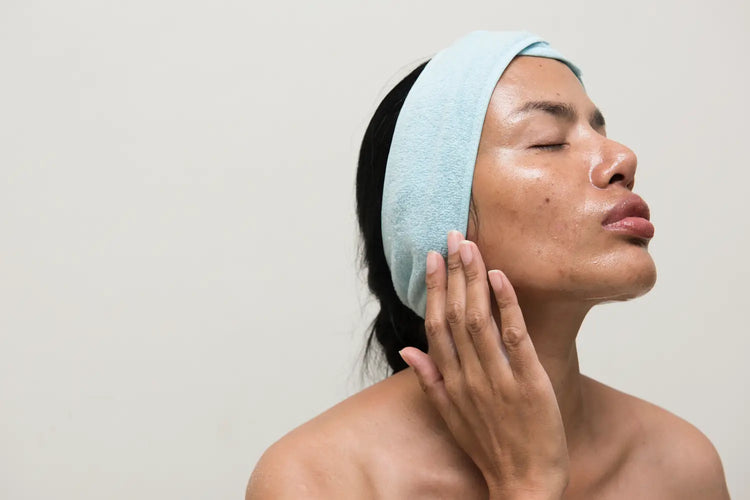It’s not uncommon to see oily skin — if that’s your skin type — as the enemy, or as a problem to be solved.
However, your skin type is simply a part of your body, and the goal isn’t to overcome it… it’s all about learning how to properly understand your skin type so that you can maintain a balanced complexion.
To help you find equilibrium with your complexion, let’s break down everything you need to know. From excess oil production to blackheads to other types of breakouts and impurities, we’ll help you demystify your skin type so you can do more than just survive it — you’ll find ways to help your skin thrive.
How Can You Identify Your Skin Type?
Why does your face seem like it's set to "extra shine" mode? Is this simply how your skin behaves, or is there something more to it?
If these questions keep you awake at night, step one is identifying your skin type. Each skin type has unique characteristics, and while consulting a dermatologist can give you an in-depth evaluation, including readings on your skin's water content, lipid levels, and resilience … there’s a certain extent to which you can pretty easily evaluate your own complexion.
If you notice excess sebum and shine all over your face, you probably have oily skin. Breakout-prone skin is also often oily. If you find that your complexion is oily largely around your T-zone, it’s likely that you actually have combination skin, which requires different methods to help maintain its balance.
Understanding your skin type allows you to explore targeted skincare routines involving cleansers, moisturizers, and even face washes that harmonize with your skin’s unique oil production levels. If you have oily skin, products with salicylic acid, benzoyl peroxide, or antioxidants like green tea might soon become staples in your skincare arsenal.
What Biological Factors Influence Your Skin Type?
The canvas of your skin is influenced by a myriad of biological actors, each contributing to and interacting with your oily skin in different ways. From the oil-producing mechanisms to the hormonal mix that governs them, understanding these biological factors offers you the kind of clarity that can be transformational for your skincare journey.
The sebaceous glands might be microscopic, but their influence on your skin is anything but small. They secrete an oily substance called sebum, designed to moisturize the skin and protect it from external harm. But what happens when these glands decide to go rogue?
Hormonal Fluctuations
At times, the culprit behind your skin’s oiliness may not be what you put on your face but what’s happening inside your body. Hormones like cortisol, colloquially known as the “stress hormone,” have a direct influence on your skin's sebum production.
Increased stress levels can trigger cortisol, which in turn ramps up oil production, disrupting your skin’s natural equilibrium. In addition to “natural” hormone fluctuations caused by stress, puberty, or pregnancy, your hormones can also fluctuate due to medication that impacts your hormones, like birth control.
External Triggers
Your skin is a responsive organ, often reflecting the conditions of your surrounding environment. While your biological makeup certainly influences how your skin behaves, external factors can also significantly impact the amount of oil your skin produces.
Humid climates are a catalyst for your sebaceous glands, enticing them to produce more oil than needed. On the flip side, the dry winter air can create a situation where your skin overcompensates for the lack of moisture by producing excess oil. As seasons change, so should your skincare routine.
Diet and Nutrition
The saying "you are what you eat" holds more truth than you might realize, especially when it comes to your skin. High-glycemic foods like fries and sugary delights can lead to fluctuations in your blood sugar levels, stimulating your body to produce more androgens. Increased levels of these hormones can escalate oil production, resulting in a plethora of skin problems, including acne breakouts, blemishes, and large pores.
A balanced diet rich in antioxidants, found in fruits like berries and beverages like green tea, can contribute to skin health. Integrate foods rich in omega-3 fatty acids, such as fish and flaxseeds, to regulate oil production. And while you may not need to bid a tearful farewell to your favorite treats, approaching them with moderation can be your golden ticket to a happier, less oily skin landscape.
How Can You Manage Oily Skin?
The road to controlling oily skin is paved with the right practices, effective products, and a touch of commitment. Crafting a routine that serves your unique skin needs can spell the difference between a greasy sheen and a balanced glow. Knowledge is power, so let's delve into the specifics.
The Right Skincare Products
When searching for the right skincare products, scrutinizing ingredient labels is a must. For moisturization without exacerbating oiliness, focus on oil-free or water-based options. It’s also a good idea to choose non-comedogenic formulas to sidestep pore-clogging pitfalls and unsightly breakouts.
If you’re looking for a moisturizer that delivers deep hydration without clogging your pores or leaving your skin feeling heavy and uncomfortable, our Moonbounce™ 2% Bio Retinol Irish Sea Moss Plumping Moisturizer. This plant-based marvel includes a bio retinol complex that minimizes wrinkles and firms the skin without the irritation often associated with retinol. Irish sea moss and marshmallow root ensure deep hydration while maintaining skin plumpness.
Our moisturizer is also crafted with carefully sourced, 100% natural ingredients that not only nourish the skin but also feature mood-altering aromas to nourish the senses. This comprehensive approach makes the Moonbounce™ moisturizer an excellent addition to your oily skin-care routine.
Tools of the Trade
While blotting papers and sheets offer immediate respite from an oily complexion by absorbing excess sebum on the go, it’s not all about trying to sap your skin of its extra moisture. A green tea-infused face wash, packed with antioxidants, helps regulate your skin's oil glands and offers a refreshing cleanse.
A game-changing product worth mentioning here is the Empress Sweet Fern Hydrasoothe Face Mist. This cold-pressed toning mist is a multitasker that aims to brighten, de-puff, and detoxify your skin throughout the day. Rich in sweet fern, known for its purifying properties, this mist can flush the lymphatic system to promote better circulation, resulting in a more radiant and clear complexion.
Our Empress Sweet Fern Hydrasoothe Face Mist offers not just topical relief but a holistic approach to skincare, making it an indispensable part of your daily routine for combating oily skin.
What Are Some Common Mistakes To Avoid With Oily Skin?
Understanding what not to do can be just as vital as knowing what to do. Steering clear of pitfalls can put you on a path toward a balanced complexion.
Over Exfoliating
The idea of scrubbing away excess oil may be enticing, yet this strategy can backfire spectacularly. Over-exfoliating disrupts your skin's natural oil balance and can lead to dry, parched skin — which ironically can promote even more oil production, doubling down on your concern.
Instead of over-exfoliating, again, the name of the game is always balance. Opt for gentle exfoliating products that help remove debris without irritating your skin or stripping it of essential natural oils.
Choosing Harsh Products
It might sound counterintuitive to say that it’s important to moisturize oily skin — but failing to moisturize, or stripping too much moisture away from your skin, can cause your complexion to produce even more oil to compensate. For example, choosing a cleanser that’s too harsh can strip natural oils away and wreak havoc on your skin’s equilibrium.
Instead, opt for a gentle, hydrating cleanser like our Starnectar™ Barrier Protect Marshmallow Jelly Cleanser. Formulated with marshmallow root, licorice root, and orange peel, this cleanser melts away makeup and impurities while maintaining your skin's moisture barrier.
This cleanser ideal for sensitive skin and safe for the eye area, offering a warm, woodsy scent as a sensory bonus. Not only does it help balance oil production, but it also nourishes the skin barrier and offers protection from free radical damage. With ingredients chosen for their known skin, mind, and spirit benefits, this cleanser is your ticket to adequately hydrated, plump, and balanced skin.
Shine Off, Confidence On
From biological factors like hormonal changes and sebaceous glands to external triggers like diet and humid climates, oily skin can be exacerbated by a wide range of conditions — but achieving a calmer complexion is no longer a far-off dream. Once you understand your sebum production and skin type, you’re equipped to give your oily skin the kind of TLC it really deserves.
Take your first step on this enlightening journey toward balanced, radiant skin today. You have the tools, the knowledge, and the power — now it’s just time to put them into practice.
Sources:
Oily Skin: A Review of Treatment Options | National Library of Medicine
Oily Skin: An Overview | National Library of Medicine

